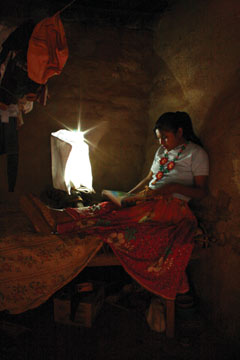|
NEWS NOTES
Traveling light
 Photo courtesy of Kennedy & Violich Architecture, LTD |
| A Huichol woman reads by the light from her “portable light” bag. During the day, solar cells on the bag absorb the sun’s energy; at night, LEDs sewn into the bag can re-emit that energy as light. |
In remote areas within Mexico’s Sierra Madre mountains live a few thousand indigenous Huichol people. Living in villages tens of kilometers from the nearest air strip or city and accessible only by four-wheel drive or by foot, many of the Huichol are impossibly far from any electric grid, and have neither electricity nor running water. But some do have light — and it’s portable.
The light is in the form of specially designed mats made of a fabric that can both harvest and store the sun’s energy during the day, and can also re-emit that energy as light when it gets dark. These “portable light” mats are the brainchild of the firm Kennedy & Violich Architecture, Ltd., which is interested in how new, lightweight and flexible technology can be integrated into different building materials, says Frano Violich, one of the firm’s partners. “We’re very interested in using fabrics in our work.”
So the materials-development arm of the firm produced a two-sided, versatile fabric that can not only store electricity to charge cell phones or GPS devices (like the solar-paneled backpacks currently available for sale in the United States) but can also produce its own light. The waterproof, tarpaulin-like outer side features flexible photovoltaic cells made, not of silicon, but of copper indium gallium diselenide, a material that is flexible and can be spread in a thin layer across another material, such as plastic. The inner side of the fabric, meanwhile, contains 200 small but powerful light-emitting diodes, or LEDs, sewn right into the material. The energy generated by the solar cells during the day is stored in small, rechargeable lithium-ion batteries (such as those used in cell phones) that are inserted into the fabric. Once charged by the sun’s energy, the bag’s owner can flip a switch and the batteries can power the LEDs for eight to nine hours, Violich says.
Armed with a grant to produce enough of the bags to test the technology, Violich’s partner Sheila Kennedy went searching for a remote location where people might find them most useful. While traveling in Mexico, Kennedy located a Huichol trading center, where she arranged to distribute the bags. It wasn’t a quick sell at first — after decades of unfulfilled promises of help by the Mexican government, “there was some suspicion” about what the firm’s goals really were in the community, Violich says. "So we kept the message simple — that we just wanted to provide portable light. We said, 'We just want this to work!'"
A year later, the portable light fabric has become “very popular,” he says. The Huichol have put their own stamp on the technology, fashioning the lightweight fabric into woven satchels resembling traditional textiles and featuring elaborate designs of deer, eagles and snakes. By day, men and women of the community carry the satchels or hang them from the roofs of their houses to harvest the sunlight; by night, the charged fabric can be removed from the bags and unfolded into a lantern-like shape to provide light for reading, cooking or making textiles. Using only two watts of power, the bags can provide 160 lumens of light — enough to read by or do nearby activities, Violich says. And the next phase of the technology would allow the units to be combined, potentially producing up to 650 lumens, which could illuminate a room, he adds.
The portable bags are a good solution for the Huichol, who can’t afford to install silicon photovoltaic cells at $5,000 apiece — and also have no way to transport them to their largely inaccessible villages. Hence, the importance of portability, Violich says. Currently, the firm is looking into distributing the fabric to other remote peoples, including aboriginal villages in Alice Springs, Australia, and the Yanomamö Indians living in the Amazon jungle between Brazil and Venezuela. The firm is also starting a project to manufacture portable light blankets that will give a similar glow.

 Subscribe
Subscribe


